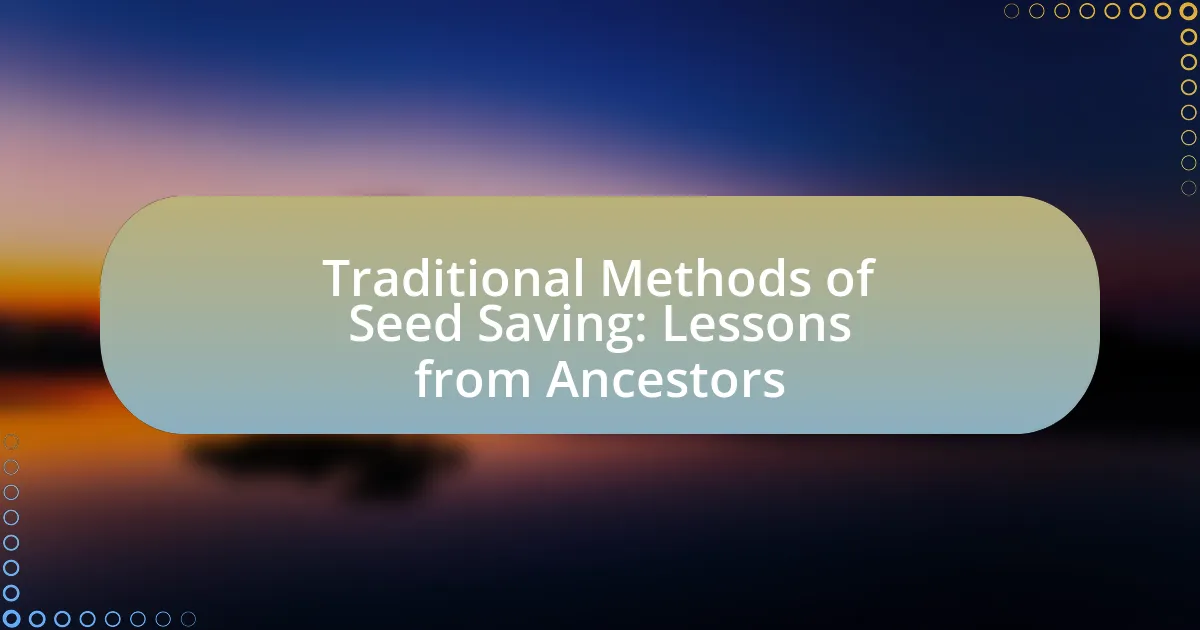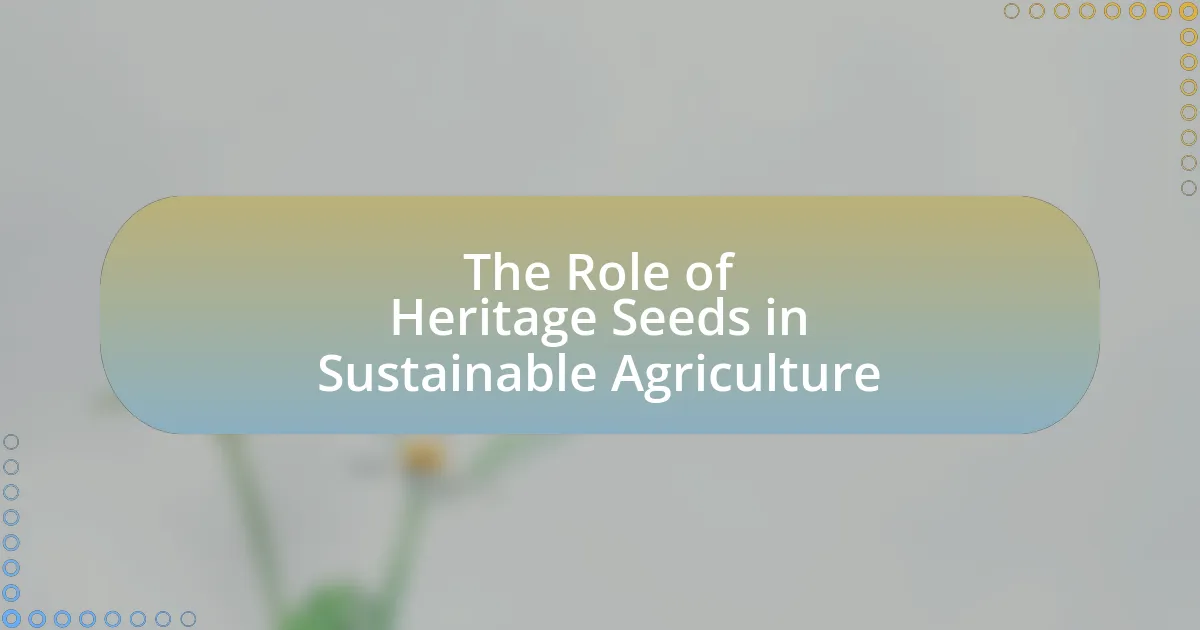The article focuses on techniques for effective seed preservation in heritage varieties, emphasizing the importance of maintaining genetic diversity and cultural heritage. Key preservation methods include proper drying, storage in cool and dark environments, and regular viability testing to ensure seeds remain capable of germination. The article also discusses the role of heritage varieties in biodiversity and food security, the challenges faced in preserving these seeds, and innovative technologies such as cryopreservation. Additionally, it outlines best practices for seed handling, storage, and the contributions of seed banks in safeguarding these vital genetic resources.

What are the Techniques for Effective Seed Preservation in Heritage Varieties?
Effective seed preservation techniques for heritage varieties include proper drying, storage in cool and dark environments, and regular viability testing. Proper drying reduces moisture content to prevent mold and decay, while storing seeds in cool, dark places slows down metabolic processes and extends shelf life. Regular viability testing ensures that seeds remain capable of germination, which is crucial for maintaining the genetic diversity of heritage varieties. Research indicates that seeds stored at low temperatures (around 4°C) and low humidity (around 20% relative humidity) can remain viable for decades, supporting the long-term preservation of these important genetic resources.
Why is seed preservation important for heritage varieties?
Seed preservation is crucial for heritage varieties because it ensures the survival of genetic diversity and cultural heritage. Heritage varieties often possess unique traits that are adapted to specific local environments, contributing to biodiversity and resilience in agriculture. According to the Food and Agriculture Organization, over 75% of crop diversity has been lost in the last century, highlighting the importance of preserving these seeds to maintain ecological balance and food security. By safeguarding heritage seeds, we protect not only the plants themselves but also the traditional farming practices and cultural identities associated with them.
What role do heritage varieties play in biodiversity?
Heritage varieties play a crucial role in biodiversity by preserving genetic diversity within agricultural systems. These varieties often possess unique traits that can enhance resilience to pests, diseases, and climate change, contributing to ecosystem stability. For instance, a study published in the journal “Agricultural Systems” highlights that heritage varieties can contain genes that are lost in modern cultivars, which are essential for breeding programs aimed at improving crop resilience. By maintaining a diverse gene pool, heritage varieties support the adaptability of crops to changing environmental conditions, thereby ensuring food security and ecological balance.
How does seed preservation contribute to food security?
Seed preservation directly contributes to food security by ensuring the availability of diverse crop varieties that can withstand environmental changes and pests. By maintaining genetic diversity through seed banks and traditional farming practices, communities can adapt to climate variability and food supply challenges. For instance, the Global Crop Diversity Trust reports that preserving a wide range of seeds can enhance resilience against diseases and climate impacts, thereby safeguarding food sources for future generations.
What are the common methods used for seed preservation?
Common methods used for seed preservation include drying, refrigeration, and cryopreservation. Drying reduces moisture content to prevent fungal growth and decay, while refrigeration slows down metabolic processes, extending seed viability. Cryopreservation involves storing seeds at extremely low temperatures, which can preserve genetic material for long periods. Research indicates that seeds stored at low moisture levels and temperatures can maintain viability for decades, demonstrating the effectiveness of these methods in preserving heritage varieties.
How does drying affect seed longevity?
Drying significantly enhances seed longevity by reducing moisture content, which is critical for preventing microbial growth and enzymatic activity that can lead to seed deterioration. Seeds with lower moisture levels, typically below 12%, exhibit increased viability and germination rates over extended periods. Research indicates that seeds stored at optimal moisture levels can remain viable for decades, while those with higher moisture content may lose viability within a few years. This correlation between drying and seed longevity underscores the importance of moisture management in seed preservation strategies for heritage varieties.
What is the significance of seed storage temperature?
Seed storage temperature is significant because it directly affects seed viability and longevity. Proper temperature control slows down metabolic processes and reduces the rate of deterioration, thereby extending the seeds’ shelf life. Research indicates that seeds stored at lower temperatures, typically around 5°C, can maintain viability for several years compared to seeds stored at room temperature, which may lose viability within months. This temperature management is crucial for preserving heritage varieties, as it ensures genetic diversity and availability for future cultivation.
What challenges are faced in preserving heritage seeds?
Preserving heritage seeds faces several challenges, including genetic erosion, loss of traditional farming practices, and climate change impacts. Genetic erosion occurs when diverse seed varieties are replaced by a few commercial hybrids, reducing biodiversity. The decline of traditional farming practices, which often involve the cultivation of heritage seeds, leads to a lack of knowledge and skills necessary for their maintenance. Additionally, climate change poses risks such as altered growing conditions and increased pest pressures, which can threaten the viability of these seeds. These challenges highlight the need for targeted conservation strategies to ensure the survival of heritage seed varieties.
How do pests and diseases impact seed preservation?
Pests and diseases significantly hinder seed preservation by causing damage to seeds and reducing their viability. For instance, insect pests can consume seeds or create entry points for pathogens, leading to infections that compromise seed health. Research indicates that fungal diseases, such as Fusarium and Aspergillus, can contaminate seeds, resulting in reduced germination rates and poor plant development. Additionally, pests like aphids can transmit viral diseases, further exacerbating the decline in seed quality. Effective management strategies, including pest control and disease monitoring, are essential to mitigate these impacts and ensure successful seed preservation.
What environmental factors threaten seed viability?
Environmental factors that threaten seed viability include temperature extremes, moisture levels, and exposure to pathogens. High temperatures can lead to seed desiccation, while low temperatures can cause frost damage. Additionally, inadequate moisture can result in seed dormancy or death, and excessive moisture can promote fungal growth, leading to rot. Pathogens such as bacteria and fungi can infect seeds, reducing their germination potential. Studies have shown that seeds stored at temperatures above 20°C experience a significant decline in viability over time, emphasizing the importance of controlled storage conditions for preservation.

How can we enhance seed preservation techniques for heritage varieties?
Enhancing seed preservation techniques for heritage varieties can be achieved through the implementation of cryopreservation, which involves storing seeds at ultra-low temperatures to maintain viability. Research indicates that cryopreservation can significantly extend the lifespan of seeds, with studies showing that seeds stored at -196°C can remain viable for decades, as demonstrated by the Svalbard Global Seed Vault, which preserves a diverse range of plant genetic material. Additionally, utilizing controlled environments with optimal humidity and temperature levels can further improve seed longevity, as evidenced by the USDA’s National Seed Storage Laboratory, which maintains seeds under specific conditions to ensure their preservation for future generations.
What innovative technologies are available for seed preservation?
Innovative technologies available for seed preservation include cryopreservation, seed coating with bioprotectants, and controlled atmosphere storage. Cryopreservation involves storing seeds at extremely low temperatures to halt metabolic processes, effectively preserving genetic material for long periods. Research has shown that this method can maintain seed viability for decades, as demonstrated in studies by the International Plant Genetic Resources Institute. Seed coating with bioprotectants enhances seed longevity by providing a protective layer that reduces desiccation and microbial damage. Controlled atmosphere storage regulates temperature and humidity, creating optimal conditions that extend seed shelf life, supported by findings from the Food and Agriculture Organization. These technologies collectively contribute to the effective preservation of heritage seed varieties.
How does cryopreservation work for seeds?
Cryopreservation for seeds involves cooling seeds to extremely low temperatures, typically below -150 degrees Celsius, to halt all metabolic processes and preserve their viability. This technique utilizes liquid nitrogen as a cryogenic agent, which effectively prevents ice crystal formation that can damage cellular structures. Research has shown that seeds stored in cryopreservation can remain viable for decades, with studies indicating successful germination rates after 20 years of storage at these temperatures. The method is particularly beneficial for preserving genetic diversity in heritage varieties, ensuring that rare and endangered plant species can be maintained for future cultivation and research.
What are the benefits of using desiccants in seed storage?
Desiccants provide significant benefits in seed storage by effectively reducing moisture levels, which helps to prolong seed viability. Lower moisture content minimizes the risk of fungal growth and seed deterioration, thereby enhancing the longevity of seeds. Research indicates that seeds stored at lower humidity levels can maintain germination rates above 80% for several years, compared to seeds stored in high humidity, which may lose viability within months. Additionally, desiccants can help maintain optimal storage conditions, ensuring that seeds remain viable for future planting and preserving genetic diversity in heritage varieties.
What traditional methods can be employed for effective seed preservation?
Traditional methods for effective seed preservation include drying, storage in cool and dark environments, and using natural materials like clay or ash for protection. Drying seeds reduces moisture content, which is crucial as high moisture can lead to mold and decay. Storing seeds in cool, dark places minimizes temperature fluctuations and light exposure, both of which can degrade seed viability. Additionally, using natural materials such as clay or ash can create a protective barrier against pests and pathogens, further enhancing seed longevity. Historical practices have shown that these methods can significantly extend the shelf life of seeds, ensuring their availability for future planting seasons.
How can farmers utilize local knowledge for seed saving?
Farmers can utilize local knowledge for seed saving by incorporating traditional practices and community wisdom regarding seed selection, storage, and cultivation. This local knowledge often includes insights on which seed varieties are best suited for specific environmental conditions, pest resistance, and optimal harvesting times. For instance, farmers in various regions have historically selected seeds based on their performance in local climates, leading to the preservation of heritage varieties that are well-adapted to those conditions. Research indicates that such practices can enhance biodiversity and improve crop resilience, as seen in studies highlighting the success of indigenous farming methods in maintaining seed diversity and sustainability.
What are the best practices for hand-pollination and seed collection?
The best practices for hand-pollination and seed collection involve careful timing, technique, and environmental considerations. For hand-pollination, it is essential to select flowers at the right stage, typically when they are fully open but before they begin to wilt. Using a small brush or cotton swab, gently transfer pollen from the male anthers to the stigma of the female flower to ensure successful fertilization. This method increases the likelihood of seed set in plants that may not be effectively pollinated by natural pollinators.
For seed collection, the optimal time is when seeds are fully mature, which can be identified by changes in color or firmness. Collect seeds on a dry day to minimize moisture, and store them in a cool, dark place to maintain viability. Proper labeling of seed packets with the variety name and collection date is crucial for future planting. These practices are supported by research indicating that timely and careful pollination and seed collection significantly enhance seed quality and germination rates, particularly in heritage varieties that may have specific pollination requirements.

What are the best practices for maintaining seed viability in heritage varieties?
The best practices for maintaining seed viability in heritage varieties include proper storage conditions, regular viability testing, and careful seed handling. Maintaining seeds in a cool, dark, and dry environment significantly reduces moisture levels, which is crucial since high humidity can lead to mold and decay. Regular viability testing, such as germination tests, ensures that seeds remain capable of sprouting, allowing for timely replacement if viability declines. Additionally, careful handling during planting and storage minimizes physical damage, which can compromise seed integrity. These practices are supported by research indicating that seeds stored at lower temperatures and humidity levels can retain viability for longer periods, with some heritage seeds lasting decades when properly cared for.
How can seed banks contribute to the preservation of heritage varieties?
Seed banks contribute to the preservation of heritage varieties by collecting, storing, and maintaining genetic diversity of these plants. They ensure that heritage varieties, which often possess unique traits and adaptations, are safeguarded against extinction due to environmental changes, loss of agricultural practices, or market pressures. For instance, the Svalbard Global Seed Vault, established in 2008, serves as a global backup for seed collections, preserving over a million seed samples from around the world, including numerous heritage varieties. This secure storage allows for the potential revival of these varieties in the future, supporting biodiversity and food security.
What are the key features of a successful seed bank?
A successful seed bank is characterized by comprehensive genetic diversity, effective storage conditions, and robust management practices. Comprehensive genetic diversity ensures a wide range of plant varieties, which is crucial for resilience against pests and climate change. Effective storage conditions, including optimal temperature and humidity levels, preserve seed viability over time; for instance, seeds stored at -18°C can remain viable for decades. Robust management practices involve regular monitoring of seed health and germination rates, as well as thorough documentation of seed origins and characteristics, which enhances traceability and research potential. These features collectively contribute to the long-term sustainability and effectiveness of seed banks in preserving heritage varieties.
How do seed banks ensure genetic diversity?
Seed banks ensure genetic diversity by collecting and preserving a wide range of plant varieties, including heirloom and heritage seeds. They achieve this through systematic collection efforts that target diverse genetic material from various geographical regions and ecosystems. For instance, the Svalbard Global Seed Vault houses over a million seed samples from around the world, representing thousands of species, which helps maintain genetic variation essential for adaptation and resilience. Additionally, seed banks often employ techniques such as controlled pollination and cross-breeding to enhance genetic diversity within their collections, ensuring that they can provide a robust genetic resource for future agricultural needs.
What practical tips can be applied for effective seed preservation?
To effectively preserve seeds, store them in a cool, dry, and dark environment to prevent moisture and light exposure, which can lead to deterioration. Using airtight containers, such as glass jars or vacuum-sealed bags, helps maintain optimal humidity levels. Additionally, labeling containers with the seed variety and date of storage ensures proper tracking of seed viability. Research indicates that seeds stored at temperatures below 50°F (10°C) can significantly extend their lifespan, with some seeds remaining viable for decades under ideal conditions.
How should seeds be prepared for long-term storage?
Seeds should be dried to a moisture content of 5-7% before long-term storage. This low moisture level prevents mold growth and seed deterioration, ensuring viability over time. To achieve this, seeds can be spread out in a single layer in a cool, dark, and well-ventilated area for several days. Once dried, seeds should be stored in airtight containers, such as glass jars or vacuum-sealed bags, to protect them from humidity and pests. Additionally, storing seeds in a cool environment, ideally at temperatures below 50°F (10°C), further enhances their longevity. Research indicates that proper drying and storage conditions can significantly extend seed viability, with some seeds remaining viable for decades when stored correctly.
What are the common mistakes to avoid in seed preservation?
Common mistakes to avoid in seed preservation include improper storage conditions, neglecting seed viability testing, and failing to label seeds accurately. Improper storage conditions, such as high humidity and temperature fluctuations, can lead to seed deterioration; seeds should be stored in a cool, dry place to maintain their viability. Neglecting seed viability testing can result in planting seeds that do not germinate, which undermines the preservation effort; conducting germination tests before planting ensures that only viable seeds are used. Lastly, failing to label seeds accurately can lead to confusion and misidentification, making it difficult to track heritage varieties; clear labeling with the variety name and date of storage is essential for effective management.





